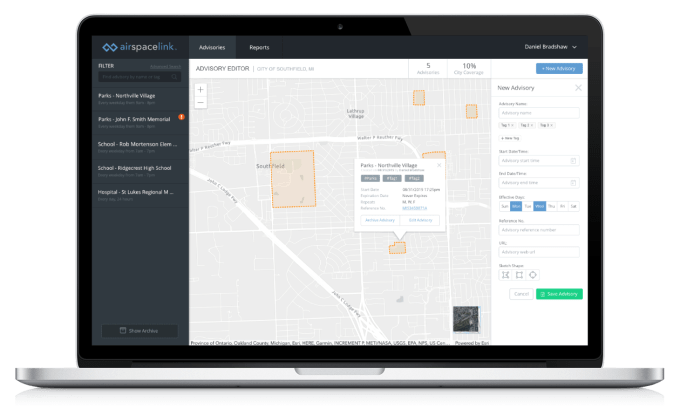Airspace Link is today announcing it raised a $10 million Series A from Altos Ventures, Thales, and others. The Detroit, Michigan-based startup anticipates using the additional funds to expand its domestic offering and expand overseas.
CEO Michael Healander explains to TechCrunch that the company sees airspaces as digital infrastructure lacking critical regulations. “Today you have rules and regulations on the road,” he says, explaining that the company is building digital roads and management for drones. Airspace Link’s novel platform addresses drone operators’ and communities’ concerns, enabling pilots to safely fly while complying with local airspace restrictions.

Airspace Link’s AirHub is the first cloud-based drone platform focused exclusively on merging the needs of state & local government with the operational planning tools pilots already use.
is the first cloud-based drone platform focused exclusively on merging the needs of state & local government with the operational planning tools pilots already use.
Airspace Links offers drone operation planning tools, including API access that allows developers to incorporate Airspace Link’s data into third-party platforms. The company’s system complies with the FAA’s Low Altitude Authorization and Notification Capability (LAANC), enabling drone pilots to submit operations while flying in controlled airspace. The company is one of seven FAA-approved companies to provide this service.
With the Series A funding, Healander says the goal is to integrate with as many transportation groups as possible.
Founded in 2018 by Michael Healander, Daniel Bradshaw, and Ana Healander, the Detroit-based startup employs 20 full-time staff. The company says in a press release that it has partnerships with over 40 government agencies and municipalities in the United States. Going forward, the company is looking to expand to Australia and Canada.
According to Healander, what distinguishes Airspace Link from the other competitors in the market is its integration with mapping tools used by municipal governments to provide information on ground-based risk.
“Our core purpose is to safely integrate drones into the national airspace and our communities at scale,” said Healander. “We thank Altos Ventures and Thales for joining our vision of paving the way for the drone economy with shared, neutral, and affordable UAS infrastructure.”
For Healander, Airspace Link is only the latest entrepreneurial venture. He previously founded GeoMetri, an indoor GPS tracking company, which was acquired by Acuity Brands.
Altos Ventures led Airspace Link’s Series A round, with participation from Thales, a global leader of air traffic management systems.
“As Unmanned Aircraft Systems (UAS) usage continues to grow, for safe, low altitude operations around communities, airspace management must combine both air and ground insights,” said Todd Donovan, Thales Vice President, Airspace Mobility Solutions Americas. “Our deep knowledge of airspace management and Airspace Link’s expertise in geospatial intelligence are the perfect combination to address this complex challenge.”
from TechCrunch https://ift.tt/3iayLCP
via IFTTT
Comments
Post a Comment